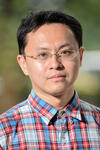Hanghui Chen
Both theoretically and experimentally, enormous progress has been made toward understanding and controlling materials at the atomic scales. The advances in thin film deposition techniques make it possible to grow artificially designed heterostructures that do not exist in nature. The theoretical developments of ab initio calculations combined with the rapid increase of computational capability enable scientists to analyse data, make predictions and even design experiments from numerical simulations. In this thesis, as a good demonstration, we use Density Functional Theory to investigate structural, electronic and magnetic properties of oxide interfaces. Transition metal oxides are complex materials in which charge, spin, orbital and lattice are all coupled to each other, resulting in many competing phases. Oxide interfaces are more intriguing because unexpected novel phenomena emerge that are absent in both bulk constituents. We study three interesting and representative oxide interfaces. The first is the interface between band insulators SrTiO3 and LaAlO3. A comprehensive investigation of electronic and atomic reconstructions at the interface is presented and different scenarios of formation of two dimensional electron gas at the interface are provided. The second example is the interface between ferroelectrics and manganites. The couplings of ferroelectric polarization to charge, spin and orbital occupancy in manganites are studied in details. Comparisons to existent experiments and predictions for new experiments are presented. The last interface investigated is the one between simple metals and binary oxides. We show that when the interface structure is carefully engineered, a pair of unstable metal-O bonds could induce ferroelectricity in otherwise paraelectrics. If this interfacial ferroelectricity is combined with magnetic insulators, multiferroics can be formed in ultra thin films.
